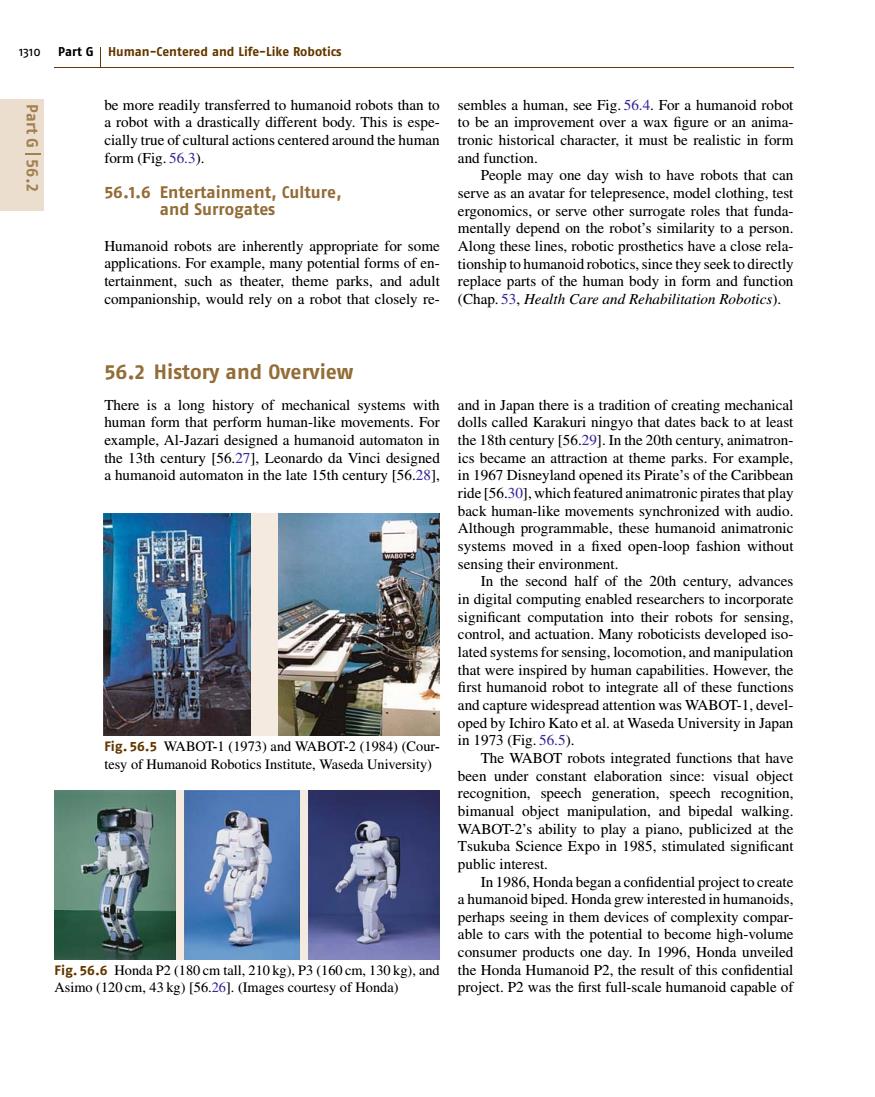正在加载图片...

1310 Part G Human-Centered and Life-Like Robotics be more readily transferred to humanoid robots than to sembles a human,see Fig.56.4.For a humanoid robot Part G156 a robot with a drastically different body.This is espe- to be an improvement over a wax figure or an anima- cially true of cultural actions centered around the human tronic historical character,it must be realistic in form form (Fig.56.3). and function. People may one day wish to have robots that can 56.1.6 Entertainment,Culture, serve as an avatar for telepresence,model clothing,test and Surrogates ergonomics,or serve other surrogate roles that funda- mentally depend on the robot's similarity to a person. Humanoid robots are inherently appropriate for some Along these lines,robotic prosthetics have a close rela- applications.For example,many potential forms of en- tionship to humanoid robotics,since they seek to directly tertainment,such as theater,theme parks,and adult replace parts of the human body in form and function companionship,would rely on a robot that closely re- (Chap.53,Health Care and Rehabilitation Robotics). 56.2 History and Overview There is a long history of mechanical systems with and in Japan there is a tradition of creating mechanical human form that perform human-like movements.For dolls called Karakuri ningyo that dates back to at least example,Al-Jazari designed a humanoid automaton in the 18th century [56.29].In the 20th century,animatron- the 13th century [56.27],Leonardo da Vinci designed ics became an attraction at theme parks.For example, a humanoid automaton in the late 15th century [56.28], in 1967 Disneyland opened its Pirate's of the Caribbean ride [56.30],which featured animatronic pirates that play back human-like movements synchronized with audio. Although programmable,these humanoid animatronic systems moved in a fixed open-loop fashion without sensing their environment. In the second half of the 20th century,advances in digital computing enabled researchers to incorporate significant computation into their robots for sensing, control,and actuation.Many roboticists developed iso- lated systems for sensing.,locomotion,and manipulation that were inspired by human capabilities.However,the first humanoid robot to integrate all of these functions and capture widespread attention was WABOT-1,devel- oped by Ichiro Kato et al.at Waseda University in Japan Fig.56.5 WABOT-1(1973)and WABOT-2(1984)(Cour- in1973Fig.56.5). tesy of Humanoid Robotics Institute,Waseda University) The WABOT robots integrated functions that have been under constant elaboration since:visual object recognition,speech generation,speech recognition, bimanual object manipulation,and bipedal walking. WABOT-2's ability to play a piano,publicized at the Tsukuba Science Expo in 1985,stimulated significant public interest. In 1986,Honda began a confidential project to create a humanoid biped.Honda grew interested in humanoids, perhaps seeing in them devices of complexity compar- able to cars with the potential to become high-volume consumer products one day.In 1996,Honda unveiled Fig.56.6 Honda P2 (180 cm tall,210kg),P3 (160 cm,130kg),and the Honda Humanoid P2,the result of this confidential Asimo (120 cm,43 kg)[56.26].(Images courtesy of Honda) project.P2 was the first full-scale humanoid capable of1310 Part G Human-Centered and Life-Like Robotics be more readily transferred to humanoid robots than to a robot with a drastically different body. This is especially true of cultural actions centered around the human form (Fig. 56.3). 56.1.6 Entertainment, Culture, and Surrogates Humanoid robots are inherently appropriate for some applications. For example, many potential forms of entertainment, such as theater, theme parks, and adult companionship, would rely on a robot that closely resembles a human, see Fig. 56.4. For a humanoid robot to be an improvement over a wax figure or an animatronic historical character, it must be realistic in form and function. People may one day wish to have robots that can serve as an avatar for telepresence, model clothing, test ergonomics, or serve other surrogate roles that fundamentally depend on the robot’s similarity to a person. Along these lines, robotic prosthetics have a close relationship to humanoid robotics, since they seek to directly replace parts of the human body in form and function (Chap. 53, Health Care and Rehabilitation Robotics). 56.2 History and Overview There is a long history of mechanical systems with human form that perform human-like movements. For example, Al-Jazari designed a humanoid automaton in the 13th century [56.27], Leonardo da Vinci designed a humanoid automaton in the late 15th century [56.28], Fig. 56.5 WABOT-1 (1973) and WABOT-2 (1984) (Courtesy of Humanoid Robotics Institute, Waseda University) Fig. 56.6 Honda P2 (180 cm tall, 210 kg), P3 (160 cm, 130 kg), and Asimo (120 cm, 43 kg) [56.26]. (Images courtesy of Honda) and in Japan there is a tradition of creating mechanical dolls called Karakuri ningyo that dates back to at least the 18th century [56.29]. In the 20th century, animatronics became an attraction at theme parks. For example, in 1967 Disneyland opened its Pirate’s of the Caribbean ride [56.30], which featured animatronic pirates that play back human-like movements synchronized with audio. Although programmable, these humanoid animatronic systems moved in a fixed open-loop fashion without sensing their environment. In the second half of the 20th century, advances in digital computing enabled researchers to incorporate significant computation into their robots for sensing, control, and actuation. Many roboticists developed isolated systems for sensing, locomotion, and manipulation that were inspired by human capabilities. However, the first humanoid robot to integrate all of these functions and capture widespread attention was WABOT-1, developed by Ichiro Kato et al. at Waseda University in Japan in 1973 (Fig. 56.5). The WABOT robots integrated functions that have been under constant elaboration since: visual object recognition, speech generation, speech recognition, bimanual object manipulation, and bipedal walking. WABOT-2’s ability to play a piano, publicized at the Tsukuba Science Expo in 1985, stimulated significant public interest. In 1986, Honda began a confidential project to create a humanoid biped. Honda grew interested in humanoids, perhaps seeing in them devices of complexity comparable to cars with the potential to become high-volume consumer products one day. In 1996, Honda unveiled the Honda Humanoid P2, the result of this confidential project. P2 was the first full-scale humanoid capable of Part G 56.2